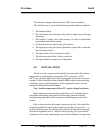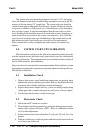
1-16 Part III
Part III Model 6600
Teledyne Analytical Instruments
Particulate laden, turbid, dirtier waters where algae, bacteria,
etc., could collect on the sample cell windows, such as:
1 refinery effluents
2 ponds
3 stagnated effluents
4 oil chemical separators, etc.
In these applications, in addition to the normal autozero liquid functioning,
the backflushing can be used preceding the liquid autozeroing by momen-
tarily actuating when optioned the two solenoid valves sv1 and sv2 across
the sample cell for about 15 seconds before the zero liquid is allowed to
enter the sample cell for background non-organic compound corrections.
The preset open period of the solenoid valves (approximately 15 seconds) is
sufficient to provide a stream of air to the sample cell inlet port at the begin-
ning of each zero cycle. This jet air evacuates the process water and any
collected residue from the sample cell once each hour, vastly reducing the
maintenance that would otherwise be required to keep the cell free of algae
and other debris. The cell inlet/outlet ports are designed with proper sample
inlet/outlet angles across the sapphire windows (non-scratching) thereby
creating high velocity and turbulence both in the normal measuring liquid
stream mode and also during the backflushing cleaning and/or autozeroing
modes described above.
3.5 The Signal Outputs
The standard signal output of the analyzer is 0-1 volt located on the control unit
Interface Board.
The current outputs of the analyzer are isolated 4-20 mA.. The circuit
adjustment procedures the described on section 3, part 1 of this manual.
3.6 Recorder Requirement
The system requires a recorder with input sensitivity which matches the
specified system signal output.
Instruments with floating (ungrounded) current outputs can be connected to any
current input recorder.


















